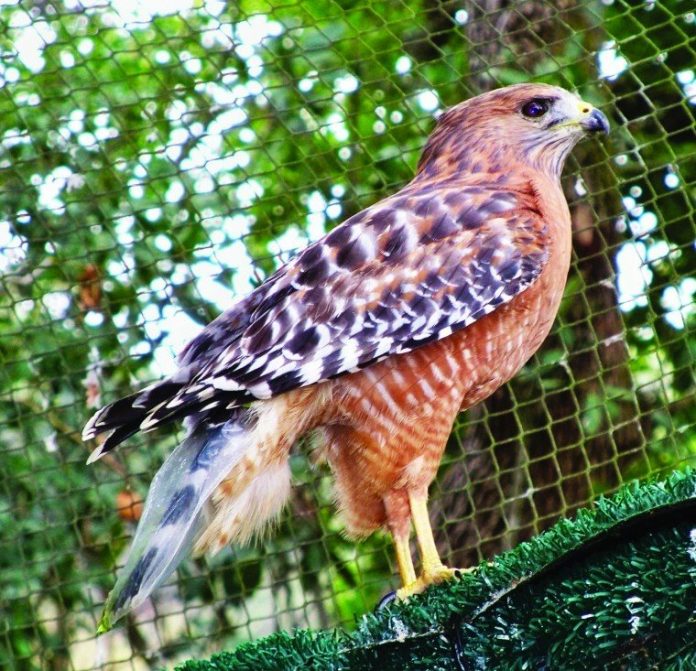One of our local avian citizens has some wonderful people for whom to be thankful this year. At a field near downtown Morgan Hill last month, it’s believed that this red-shouldered hawk was being attacked by a pair of much larger red-tailed hawks, who knocked the competing red-shoulder to the ground and badly bruised her wing. After being rescued and transported to the Wildlife Education and Rehabilitation Center, the hawk’s exam showed that the right wing had painfully limited extension and the hawk could not stand well, but instead would totter over onto her side. A more visible and serious injury was feared – her left eye was covered by thick mucus surrounding the cornea. WERC staff cautiously cleansed the eye with warm water, which moved the tip of a foreign object into view. With tweezers, two foxtails were delicately removed from under the top eyelid and from the inner corner of the eye. Apparently, the hawk’s desperate flailing on the weed-covered ground had allowed the offending foxtails to enter the eye, causing the secondary injury.
Thankfully, the foxtails had not perforated the eye or the lids and with a daily application of eye medication, the eye quickly healed. However, she would not eat on her own for the first couple of days – though that is not unusual for a captive wild bird in rehabilitation. For several days, volunteers administered fluids and hand-fed her small rodents to provide necessary hydration and sustenance to the underweight raptor. After a week, the hawk was moved to a small outdoor enclosure to assess its flight capabilities. Though she had a slight wing droop, she was flying well enough to be transferred to a large flight enclosure, where she could fully exercise and perfect her flight so she could be released. Her food was placed at ground level to ensure her vision had not been compromised.
In the wild, red-shouldered hawks typically perch patiently and quietly on a tree, telephone pole or fence post waiting for a potential meal to come into view and then swoop down on their prey, which consists of a veritable carnivorous cornucopia of nature’s bounty: Gophers, mice, moles, voles, rabbits, squirrels, amphibians, reptiles, large insects and small birds (sometimes including “ready-to-serve” birds commonly found at backyard feeders – as I witnessed first-hand when a “neighborhood” hawk caught a plump-collared dove in my yard).
Red-shouldered hawks are aggressive and territorial, and will sometimes attack and lock talons with intruding hawks. While defending its territories, the hawk makes its presence loud and clear – screaming its characteristic kee-yeeer call. WERC volunteers can testify to such behavior: A noisy red-shouldered hawk living in the woods around the center becomes especially territorial in the spring and will attempt to attack any red-shouldered hawk that is inside the flight enclosure. Crows, too, will often mob a red-shouldered hawk, as evidenced by a previous red-shoulder patient of WERC’s, which had all his head feathers pulled out bloodily by a marauding horde of crows that were probably protecting their own young from the hawk. On the other hand, sometimes these two “enemies” will cooperate to assail red-tailed hawks and great horned owls that threaten them and their babies.
An important reason the adult female hawk needed to be released back to her original habitat was so that she could hopefully reunite with her mate. Red-shouldered hawks are monogamous and return to the same nesting territory year after year. The nest is built by both parents in a large tree and is made of sticks, then lined with dried leaves, bark, moss, lichens and feathers. Protective and conscientious parents, the hawks add fresh leaves throughout the nesting season to keep the nest soft and clean for their eggs and nestlings.
After recuperating for a month, the hawk was released on a warm, cloudless day in early November at a field near where she had been found. She was perfectly gorgeous with her beautiful, rich brick-red breast, head and shoulders, and striped wings. Her feathers were in prime condition (thanks to a tail sheath that kept her black-and-white-banded tail feathers from cracking and breaking while she was in the enclosure). Watching her gracefully fly up into a tree and then into the blue yonder, it seemed especially fitting that the scientific name for her California subspecies, Buteo elegans, means “elegant soaring hawk.”
“And all of those who see me, all who believe in me
“Share in the freedom I feel when I fly.”
– The Eagle and the Hawk by John Denver














